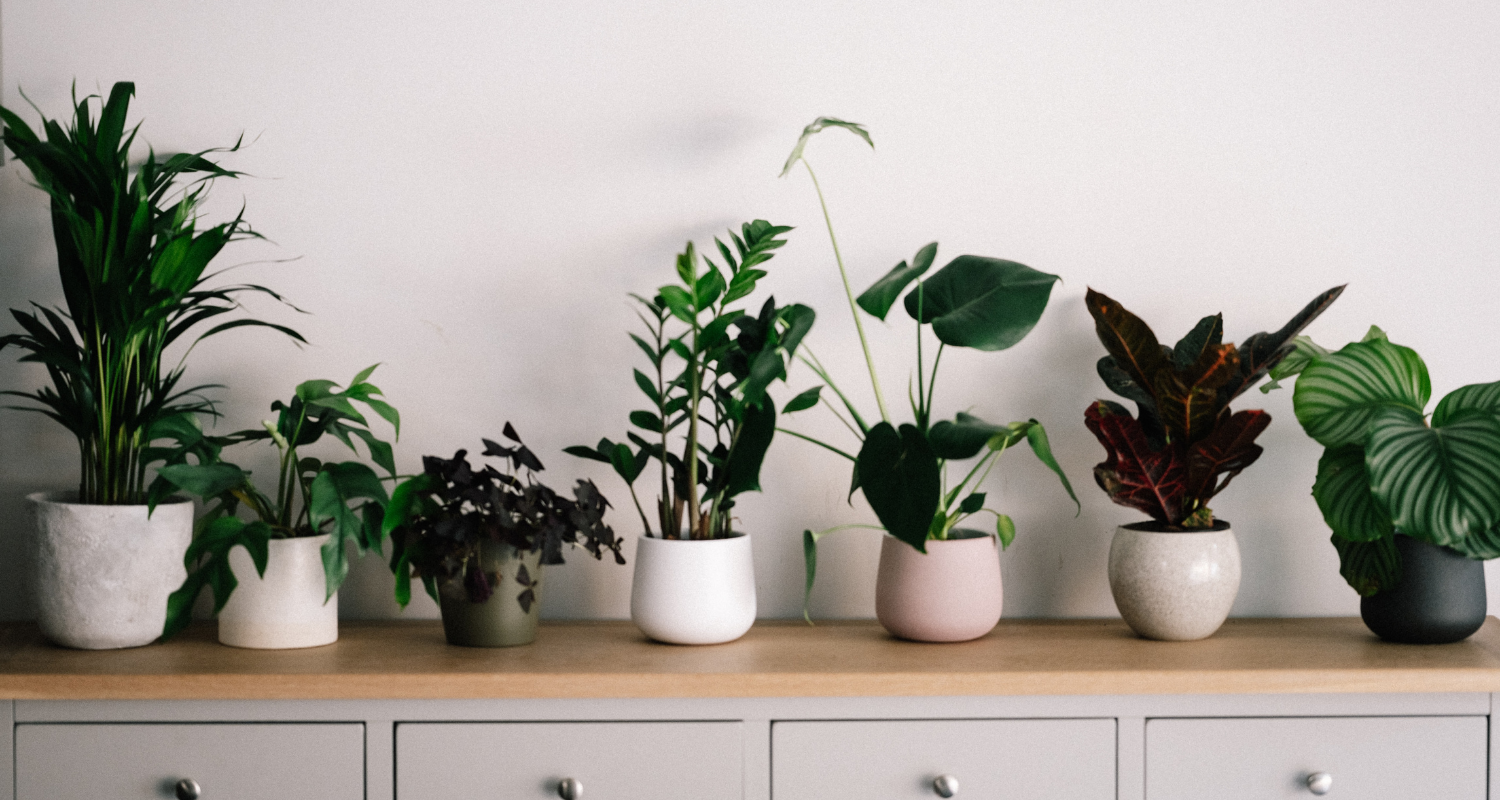
If a lack of natural light is the only thing keeping you from adding plants to your home, wait no more. There’s a wide range of unique and beautiful low-light varieties perfect for indoor spaces. With the help of plant expert and owner of Meraki Market, a plant and home decor shop in Haddonfield, New Jersey, Madison Ramirez, we’ve compiled a list of easy-to-find, vibrant indoor greenery to breathe life into low-light interior spaces, along with tips and tricks to help these beauties flourish. Prayer plants (Maranta leuconeura) hail from the tropics of Brazil. They feature oval tri-colored leaves with feathery veins that almost look painted on. They get their name from the graceful leaves that fold in together at night, like a pair of praying hands. Prayer plants come in many varieties, each with unique coloring. Prayer plants enjoy high humidity, so they work well in groupings with other plants that give off moisture. When grown indoors, they don’t often produce flowers. Their real beauty is in their brilliant green leaves. Prayer plants are especially versatile and work well in different areas of the home. Prayer plants will grow graceful trailing vines in a hanging basket or perched atop a high wall shelf. Or you can prune back the stems regularly to maintain a more compact, round and bushy shape. Because they have specific needs (including high humidity and filtered or distilled water) Ramirez concedes, “Prayer plants are a little finicky — but I do find them the most beautiful!” The eye-catching tropical Monstera adansonii’s common name, swiss cheese vine, refers to its uniquely perforated leaves. Scientists believe these holes allow Monstera to withstand strong winds and allow light to reach down to the lowest parts of the plant in its natural environment. Like prayer plants, Swiss cheese vines look dramatic in a modern, iron hanging pot or stationed on a high shelf, where its lacy leaves can drape down. It’s also important to keep Monstera up high where pets cannot reach, as this plant is toxic to animals. In their natural tropical environment, Swiss cheese plants grow vertically using the support of fellow plants in their environment. If you don’t have pets, you might try mimicking this process by training your plant on a moss pole. Using a moss pole as a stake, attach a piece of fine wire mesh to the moss with wood staples. Mist the stake regularly and repot around every three years. Lucky bamboo is not a type of bamboo at all. It is actually the cane cuttings of the Dracena sanderiana. Since Confucian times, lucky bamboo has been associated with resilience and fortitude. In Feng Shui, bamboo is said to attract “chi” or positive life force. Because of its association with good energy and good fortune, many people like to keep lucky bamboo in their home office. Some cultures believe that placing lucky bamboo in the southeast spot of the home will increase prosperity and wealth — and that giving a bamboo plant as a gift is said to bring good luck to the giver and the receiver. The number of stalks on the lucky bamboo has significance too. For example, two stalks represent love and affection, and seven stalks bring good health. Some bamboo plants come already trained into braids, loops, and other creative shapes, which can add even more interest to your space. Lucky bamboo can grow to be two to three feet tall. Native to Australia, staghorn ferns (Platycerium bifurcatum) differ from other houseplants and other types of ferns in that they are “epiphytic,” meaning in the wild, they grow on other trees and plants. To mimic that environment in your home, you can hang staghorn ferns in baskets or mounted on a board. The plant’s distinctive fronds shoot out from the center, resembling moose or deer antlers. Mounted on rustic wooden boards or centered in square frames, staghorn ferns become living art. Wrap the root ball in burlap and attach it to a rustic piece of wood to add color and texture to gallery walls. While staghorn ferns are often mounted on planks and boards, you can also grow them in wire mesh pots or baskets and set them on a table or hang them from above. Line the container with an inch of sphagnum moss and fill it with loose, well-draining potting mix before adding the fern. The staghorn fern prefers lots of space, so use a basket or pot at least 14 inches wide. Chinese evergreen (Aglaonema commutatum) is one of the more durable and forgiving houseplants around — perfect for amateur green thumbs and forgetful plant parents. Different varieties feature oval or linear green leaves with varying patterns of silver, pink, red, or white throughout. Use colorful pots to contrast the vibrant green leaves of Aglaonema or to bring out magenta accents speckled across the leaves of certain varieties. These plants tend to stay relatively compact, so they work well on a bookcase or coffee table. While the Chinese evergreen is a slow grower, it can grow to be as tall as three to eight feet over time . Taller plants make striking accents for empty corners or next to larger pieces of furniture. Repot the Chinese evergreen every two years to encourage growth. Because this plant can survive in fluorescent light, it’s an excellent choice for a windowless bathroom or basement. Chinese evergreens are toxic to dogs, cats, and horses, so always keep them away from animals. The spider plant (Chlorophytum comosum) is another highly adaptable houseplant that is tolerant of low light. Fast-growing and forgiving, they are the perfect beginner plant for the first-time plant owner. The spider plant’s long, narrow striped green leaves reach out and arch over, giving the plant a delicate, wispy appearance. Chlorophytum comosum gets its common name from the miniature offshoot plants that develop at the end of their long stem which resemble little spiders. Spider plants are safe for pets, so these are a good option for coffee tables, kitchen counters, and other more accessible areas. Modern plant stands stationed in a corner or atop an entryway table make perfect homes for the cheerful spider plant. If you want to grow long spiderettes, hang your spider plant in a corner that sees indirect light. Another hardy and dependable house plant for low-light interiors is the Philodendron scandens or heartleaf philodendron, one of the more than 480 varieties of philodendron known to exist. Philodendron varieties come in all shapes and sizes. Some have leaves as small as three inches, and others have leaves reaching as long as three feet. The heartleaf philodendron features dark green, heart-shaped leaves. Leaves of the philodendron are toxic to humans and pets, causing mouth and throat irritation and possible vomiting, so place them high away from kids and animals. If you place a heartleaf philodendron on a high shelf or in a hanging basket, the vines will gently trail down for a dramatic effect. Research shows philodendrons are good at purifying the air, removing toxic chemicals, including acetone, ammonia, and formaldehyde from the environment. That makes them a good choice for a child’s bedroom, workspace, or musty basement. English ivy (Hedera helix) is a hardy and versatile houseplant. You can easily prune smaller-leaf varieties to maintain a more compact appearance. You can also train varieties to spread and climb a trellis or create an ornamental topiary. English ivy cultivars are classified primarily by their leaf shape. They range from flat leaves with five lobes to three-lobe, heart-shaped leaves, and others with curly or rippled leaves. Ivies have glossy green leaves, tinged with silver, yellow, gold, or white, depending upon the type. A sphagnum moss topiary is a wonderful way to create visual interest using indoor plants. Using a small to medium size pot, fresh sphagnum moss, and some basic supplies that you have around the house, you can train ivy into a living sculpture. This is a great project for children to express their creativity and learn the basics of plant care. English ivy works well up high in a hanging pot or on a top-shelf. Just remember that all ivies are eager to explore and need to be trimmed so they don’t overtake everything in their path. Fortunately, English ivy grows slowly enough that it is easy to reign in. To prune English ivy, just use your hands or pruning shears to cut just above a leaf. You can propagate those clippings in water or soil to make new plants. Originating from the forests of India, rex begonia (Begonia rex-cultorum) makes a striking indoor houseplant. The “stained glass” begonia in particular, has striking ruby red leaves trimmed in silver gray. “Fireworks” begonias are one of the newer cultivars featuring dramatic black, deep purple, and silver leaves that look like fireworks erupting. Since these plants love humid environments, rex begonias are ideal for the bathroom. With varieties offering bright leaves of violet, red, and silver, begonias are a great way to add color and life to stark, neutral bathrooms. (Just be mindful to keep begonias away from pets, as they can be toxic to dogs and cats.) The golden pothos (Epipremnum aureum) is a lush, vining houseplant that is great for beginner home gardeners. Also called the “Devil’s Vine”, the golden pothos has shiny, heart-shaped, bright green leaves with ivory, yellow, or gold variegation. Golden pothos is another plant that can be toxic to humans and pets, so place them away from both, maybe in a high basket or atop a tall piece of furniture. Their vibrant vines look beautiful cascading down a bookshelf or cabinet. Just make sure to keep them a few inches away from walls, as their aerial roots can attach and remove the paint. To create a larger indoor garden, you can pot golden pothos together with the Dieffenbachia carina or dumb cane plant. The dumb cane is a lush houseplant with large, vibrant green leaves. It works well with the golden pothos because they both enjoy the same humidity, soil, and lighting conditions. If you live in a home or work in an office with few or no windows, you can still be a proud plant parent. Here are some overall tips for choosing the ideal houseplants and ensuring they get all they need to thrive in low-light spaces. If you can’t find the plants mentioned above or just want something a bit more exotic, here’s a good rule of thumb choosing low-light plants: opt for plants with darker foliage. Darker leaves are a sign a plant is especially efficient at photosynthesis and can flourish without excess sunlight. Surprisingly, a little neglect goes a long way with low-light houseplants. OK, so maybe “neglect” isn’t the best word, but when it comes to these varieties, it’s not an issue if you forget watering now and then. Some plant owners compensate for lack of light by overwatering and overfertilizing indoor plants, but the opposite is best. Low-light plants can go longer without watering and feeding than plants exposed to bright light. As Ramirez cautions overzealous plant owners, “I think it’s important to mention that a lot of us tend to “over-love” our plants. Plants generally like to be left alone. The soil of your plants should dry out completely in between watering. Let them be and trust your gut; it is much easier to bring a plant back from underwatering than overwatering them.” While there are some exceptions, low-light plants generally don’t mean “no-light” plants. There are a few ways to give them the light they need. Try rotating low-light plants into brighter parts of your home for a few weeks before moving them back into darker areas. Or leave indoor lights on during the day. Artificial lighting is another way to ensure houseplants have sufficient light to make the food they need to grow and flower. There are four types of grow lights: incandescent bulbs, high-intensity discharge, light-emitting diode (LED), and fluorescent. Because fluorescent lights are safe, affordable, and versatile, they tend to be the most popular option for home growers. Generally, plants should be placed 6 inches to 12 inches away from grow lights, and they should be used during the daytime, for around 12 to 14 hours in rooms with some sunlight, and 16 to 18 hours per day in rooms without any outdoor light. House plants offer countless benefits beyond just the aesthetic. Research suggests plants are good for our physical and emotional wellness, as well. A widely-cited 1989 study by NASA found certain houseplants improved air quality by removing certain chemicals from interior spaces. Another study found microorganisms in certain plants and/or potting soil mixes effectively removed high levels of at least one volatile organic compound (VOC) benzyne within a short period of time. Houseplants help us breathe a little easier in other ways too. We know that spending time outdoors in nature is good for the body, mind, and soul. The same is true when we bring nature indoors. Research links indoor plants to reduced stress and anxiety and increased focus and sense of well-being. So now that you know what makes plants wonderful houseguests, how to choose the best varieties for your space, and ways to give them TLC, it’s time to get potting!1. Prayer plant
Care tips:
Styling advice:
2. Swiss cheese vine
Care tips:
Styling advice:
3. Lucky Bamboo
Care tips:
Styling advice:
4. Staghorn Fern
Care tips:
Styling advice:
5. Chinese Evergreen
Care tips:
Styling advice:
6. Spider Plant
Care tips:
Styling advice:
7. Heartleaf philodendron
Care tips:
Styling advice:
8. English Ivy
Care tips:
Styling advice:
9. Rex Begonia
Care tips:
Styling advice:
10. Golden Pothos
Care tips:
Styling advice:
Tips for Growing Indoor Houseplants in Low Light Conditions
1. Look for plants with darker leaves
2. Don’t overwater low-light plants
3. Rotate plants to brighter rooms
4. Try a grow light
More than just pretty plants: Indoor greenery is good for your health



